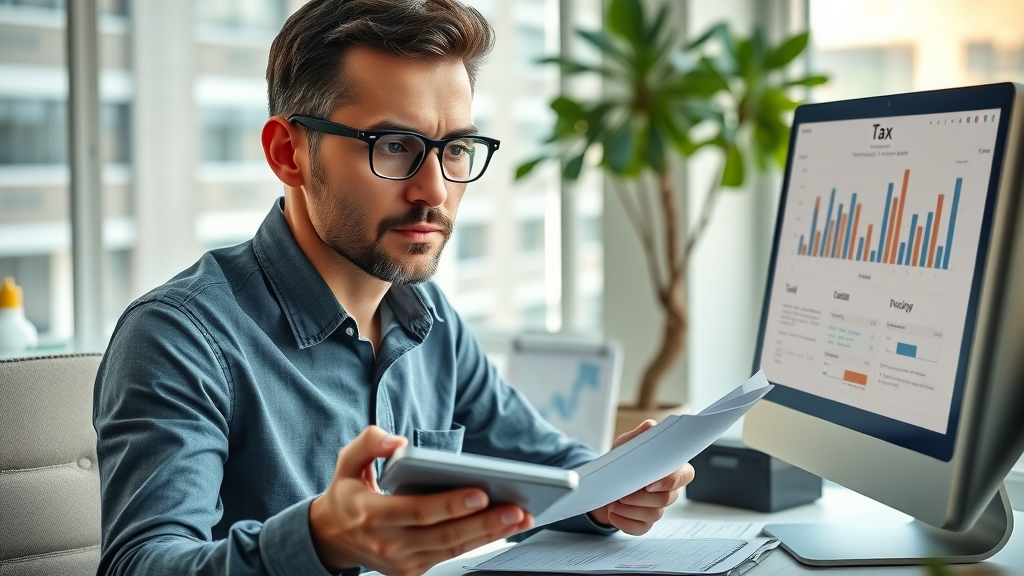Did you know nearly 60% of small businesses overpay taxes each year due to inadequate tax strategies? Strategic tax planning for business growth isn't just for large corporations—it is the lifeline for sustainability, profit maximization, and steady expansion for small businesses. Imagine transforming your financial approach to avoid unnecessary losses, capitalize on new tax incentives, and set a foundation for enduring stability. In this comprehensive guide, we’ll equip you with actionable tax planning methods, essential tax credits, and the latest tax law insights—ensuring your business is primed to thrive while sidestepping costly pitfalls.
- This article gives business owners and small businesses actionable tax planning methods, essential tax credits, and the latest tax law insights to drive sustainable business growth.
Unlocking Business Potential: Why Tax Planning for Business Growth Is Crucial
- Did you know that nearly 60% of small businesses overpay on taxes each year due to poor tax strategies? Discover how strategic tax planning for business growth can transform your finances and prevent costly mistakes.

- This article gives business owners and small businesses actionable tax planning methods, essential tax credits, and the latest tax law insights to drive sustainable business growth.
Tax planning for business growth is the key to unlocking your business’s true financial potential. Instead of scrambling to meet tax deadlines or worrying about compliance, proactive tax planning gives you the power to shape your financial future. By anticipating changes in tax law , and aligning your business decisions with these adjustments, you can proactively reduce your tax liability and free up crucial resources for reinvestment. In fact, evidence shows that businesses with a consistent tax planning process have greater profits and weather economic shifts better than those who don't plan ahead.
Consider the real impact: Imagine increasing your bottom line not by drastically raising prices or cutting expenses but simply by making smarter tax decisions. Strategic tax planning helps you access valuable tax credits, optimize tax deductions , and leverage retirement plans to lower your tax burden. From the moment you structure your business to the final details of filing your tax return, the right approach can prevent overpayment and provide ongoing growth momentum.
How Strategic Tax Planning for Business Growth Benefits Small Business Owners
- Explanation of tax planning for business growth and its impact on small businesses.
- Practical examples showcasing increased business income and minimized tax expenses.
- Statistical evidence supporting the benefits of proactive tax planning for business growth.

When small business owners invest in tax planning for business growth , they create a solid foundation for financial health. Unlike reactive approaches that only focus on compliance, strategic tax planning identifies long-term opportunities to reduce taxable income and reinvest savings into growth initiatives. For instance, properly timing income and expenses or choosing the optimal tax structure can significantly lower your effective tax rate and free additional cash for expansion.
Practical examples are everywhere—a local retailer who claimed the right tax credits saved enough for a seasonal marketing campaign; a service-based startup that accelerated deductions by purchasing equipment before year-end streamlined its business tax return and maximized working capital. These moves highlight why distinguishing between short-term compliance and strategic tax planning is essential. Data supports this: according to a study by the National Federation of Independent Business, proactive tax planning cut the average small business’s tax liability by 15-30% over five years.
It’s not just about what you save—it’s about where those savings are reinvested. Small businesses that continually analyze their taxable income , seek out new deductions, and adapt to tax law changes consistently outperform their peers. The secret weapon? A thoughtful, evolving tax plan tailored to business growth—not just survival.
What You Will Learn About Tax Planning for Business Growth
- Key concepts and principles of tax planning for business growth.
- Small business tax strategies, deductions, and credits tailored to business owners.
- Actionable methods to reduce taxable income and optimize your tax return.
- How tax law changes affect small businesses and business tax returns.
- Step-by-step planning to set up a retirement plan and leverage tax incentives effectively.

Understanding Tax Planning for Business Growth: Essential Foundations
Defining Tax Planning for Small Businesses
- Key definitions and relevance for business owners and small businesses.
Tax planning for business growth refers to the deliberate and legal process by which business owners minimize their total tax burden while ensuring compliance with new and existing tax laws . For small businesses, tax planning means more than annual paperwork—it’s the ongoing evaluation of your financial operations, structure, and timing to ensure every opportunity for savings is captured. With changing regulations, staying updated and adjusting your approaches can mean the difference between maximizing deductions and facing unnecessary expenses.
This approach requires a focus on anticipated profits (business income), expense forecasting, and the careful consideration of credits, deductions, and incentives. By being deliberate, business owners can reinvest tax savings, maintain better cash flow, and pursue growth strategies that otherwise might remain out of reach. Most importantly, proactive tax planning supports compliance, minimizes audit risks, and provides the peace of mind needed for sustainable expansion.
Think of tax planning as an investment in your business’s future. The value is not only in the money saved, but also in the efficiencies, opportunities, and agility gained when your business can respond confidently to regulatory or market shifts.
Why Tax Planning Matters for Growing Businesses
- Overview of business tax implications and tax rate effects on business income.
- How the right tax structure can drive business growth.

For small businesses on the path to growth, understanding business tax implications is critical. As revenue increases, so does your exposure to complex tax liabilities and higher tax rates. Misunderstanding how tax structures (like LLC, S Corp, or C Corp) affect your taxable income could mean missing out on significant savings. Each structure comes with unique benefits for deductions, liability protection, and the ability to claim new tax credits .
The tax rate your business faces isn't always straightforward. Adjustments in taxable income through carefully timed investments or accelerated deductions can push your company into lower brackets, reducing your total tax bill. Additionally, aligning your structure with your industry and growth stage ensures your business keeps more of what it earns—fueling innovation, hiring, and expansion opportunities.
In practical terms, a growing business that reviews its tax plan annually (or even quarterly) consistently outperforms those who don’t. The right tax strategy doesn’t just shelter yourself from risks; it becomes a lever for faster, more confident growth through every stage of your business journey.
Navigating the Tax Landscape: Small Business Tax Planning Essentials
Small Business Tax Structures: Which Is Best for Your Growth?
- Overview of different tax structures—Sole Proprietorships, LLCs, S Corps, C Corps—and their tax planning for business growth implications.
Choosing the right business tax structure is one of the most impactful decisions a small business owner can make. Each structure— sole proprietorship , LLC , S Corp , and C Corp —affects your legal liability, paperwork, and most importantly, your tax obligations and opportunities for growth. A sole proprietorship offers simplicity but provides fewer avenues for reducing income tax through deductions or splitting income. LLCs and S Corps, on the other hand, often help lower the effective tax rate by allowing pass-through of profits and flexible income distribution.
C Corps can be an attractive option for businesses planning significant expansion or eventually seeking outside investment; however, they come with their own tax considerations, such as double taxation at both the business and shareholder level. By comparing tax structures, business owners can better align with deductions, tax credits , and other incentives that fit their industry and stage of growth. Consulting with a tax advisor is recommended to pinpoint which structure offers the best tax planning advantages for your unique goals.
Ultimately, the best choice is a structure that balances immediate tax savings with long-term scalability—helping you keep more profits and reinvest them back into the business.
Key Tax Law Changes Affecting Small Businesses
- Recent updates in tax law impacting small business owners and tax planning strategies.

Over the past several years, major changes in tax law —including updates from the Tax Cuts and Jobs Act —have introduced new rules and incentives impacting small business owners nationwide. From adjustments in corporate tax rates and changes to qualified business income (QBI) deductions to the introduction of new credits and modifications to certain expense rules, these updates require close attention in your tax planning process.
For example, recent tax laws have expanded eligibility for the R&D credit, altered depreciation schedules for capital purchases, and increased the importance of keeping accurate records to support new deductions. Understanding how each change affects your particular sector or income level is essential. Staying proactive helps you avoid compliance issues, minimize your taxation, and claim every incentive that can contribute to your growth.
The smartest businesses make it a routine to review tax updates and adjust their planning at least annually. Working with a tax professional ensures you stay ahead of new regulations—maximizing benefits and keeping your growth targets in sight.
Tax Strategies for Business Growth: Maximizing Success
Proven Tax Strategies Every Small Business Owner Should Know
- Timing income and expenses to lower taxable income.
- Utilizing retirement plan contributions and relevant tax incentives.
- Effective use of tax credits, deductions, and tax planning for business growth tactics.

When it comes to tax planning for business growth , having a toolkit of proven strategies can make a monumental difference in your bottom line. One classic method is carefully timing income and expenses around the tax year-end: by deferring income to the next year and accelerating deductible expenses, you can immediately reduce taxable income.
Contributions to retirement plans, such as a SEP IRA or 401(k), offer another powerful way to lower your tax bill while building long-term financial security for you and your team. Other effective tactics include maximizing tax credits (like the Work Opportunity Credit or R&D Credit), strategically selecting the most favorable depreciation method for assets, and keeping meticulous records to support every tax deduction you claim.
Each of these approaches not only lowers your immediate tax liability but also positions your business to take advantage of future growth incentives. Consistency is key—strategic small businesses that revisit their tax strategies regularly adapt faster to regulatory changes and benefit more from new programs.
Table: Comparing Top Small Business Tax Strategies
| Tax Strategy | Description | Impact on Taxable Income | Suitability for Business Size |
|---|---|---|---|
| Accelerate Expenses | Paying for expenses before year-end to increase current deductions. | Reduces current year’s taxable income. | All sizes, especially those with fluctuating income. |
| Defer Income | Delay receipt of income until next tax year. | Pushed to subsequent year’s income. | Best for businesses with consistent revenue streams. |
| Retirement Plan Contributions | Contribute to SEP IRA, 401(k), or SIMPLE IRA for deductions. | Targets taxable income and boosts savings. | All businesses, especially those with employees. |
| Leverage Tax Credits | Apply available tax credits for hiring, R&D, and sustainability. | Directly reduces taxes owed. | Most effective for growing companies and startups. |
Quote: Expert Insight on Tax Planning for Business Growth
"Consistent, forward-thinking tax planning can mean the difference between business expansion and unexpected losses." — Leading Tax Advisor
Practical Small Business Tax Deductions and Credits for Business Owners
Maximizing Business Tax Deductions
- List of common and often-missed small business tax deductions.

Business tax deductions are the lifeblood of any effective tax planning process. Common deductions include office rent, supplies, utilities, and mileage. Many business owners overlook options like home office expenses, depreciation of technology, professional memberships, and legitimate travel expenses. Don’t forget about state tax paid, health insurance premiums (for self-employed), or interest on business loans—all can put money back in your pocket.
To maximize the benefit, keep organized and detailed records—maintain receipts, log business mileage, and track every eligible expense. Often-missed deductions can make up a significant portion of your tax savings, especially as new tax laws produce yearly changes. Reviewing your accounts with a tax professional before filing your tax return helps avoid errors and ensures no opportunities are missed.
By capturing every deduction, you minimize your taxable income , strengthen your cash flow, and fuel business reinvestment—turning ordinary operations into pathways for sustained growth.
Leveraging Tax Credits to Accelerate Business Growth
- How to identify and claim business tax credits and apply them as part of your tax planning for business growth.
Tax credits offer a direct reduction of your business’s tax bill—often yielding more value than deductions alone. To leverage these fully, review both federal and state options relevant to your sector. Popular credits include the Work Opportunity Tax Credit (WOTC), the Research and Development (R&D) Credit, and credits for energy-saving improvements.
Identifying eligibility and compiling the necessary documentation are crucial—missing the window for application could mean losing out on thousands of dollars. Consider working with a tax advisor to integrate eligible credits into your annual tax planning routine. When done correctly, these credits can free up working capital for new hires, technology upgrades, or marketing campaigns—all helping drive your next phase of business growth.
Remember, each credit has unique qualifying rules and timely deadlines, so proactive planning ensures you claim every incentive available to your business.
Tax Incentives and How They Promote Expansion
- Overview of available government tax incentives—local, state, federal—for business owners.
Beyond standard credits and deductions, government tax incentives provide additional pathways for business expansion. These can include grants, reduced state tax rates for job creation, investment incentives, and accelerated depreciation schedules for capital purchases. Local governments frequently offer property tax abatements or fee waivers to encourage relocation or redevelopment.
Staying informed about both short-term opportunities and long-standing incentives keeps your business competitive. For example, many states have dedicated programs for technology, manufacturing, or green initiatives. Pairing these with federal credits amplifies your savings and can make significant projects—like facility upgrades or workforce expansion—much more affordable.
By structuring business decisions around available incentives, you can position your company to expand responsibly while optimizing overall tax efficiency.
Cash Flow and Taxable Income Management for Business Owners
Understanding the Relationship Between Business Income and Taxable Income
- How business income impacts your overall tax strategy and planning for growth.
- Methods to accelerate deductions and defer income to optimize cash flow and minimize taxes.

Managing business income directly impacts your taxable income and long-term cash flow. Every dollar earned and every expense timed strategically can change your tax liability, affecting the funds you have available for operations and growth. Smart scheduling—like deferring high-value contracts or purchasing major equipment before year-end—maximizes deductions and smooths out tax burdens across years.
Effective tax planning for business growth blends these techniques: accelerating deductions during profitable years, deferring income if you anticipate a lower future tax rate, or leveraging one-time credits to balance cash flow needs. Consistently reviewing profit and loss statements, projected business income, and upcoming opportunities is foundational.
Not every business’s scenario is the same, so customizing your approach to suit revenue patterns and market cycles puts you in the strongest position to grow without cash-flow surprises or missed savings.
Retirement Plans as a Tax Strategy for Business Growth
The Strategic Role of Business Retirement Plans
- Types of retirement plans (SEP IRA, SIMPLE IRA, 401(k)) and their tax advantages for small business owners.
Retirement plan contributions aren’t just about long-term security—they’re a cornerstone tax reduction strategy for both business owners and employees. Common options like SEP IRAs, SIMPLE IRAs, and 401(k) plans offer generous deduction limits, letting you lower taxable income in high-earning years. Each plan type targets businesses at different stages: SEP IRAs are ideal for solo entrepreneurs or small teams, while 401(k) plans can be structured to reward and retain multiple employees.
These plans allow for pre-tax contributions, grow tax-deferred, and sometimes qualify the business for special incentives. Choosing the right plan and contributing at optimal levels not only reduces your income taxes but also helps attract talent and promote workplace loyalty—a win-win for sustainable business growth.
The best results come with annual plan reviews and strategic adjustments—maximizing your deductions as your business evolves.
Step-by-Step Guide: Setting Up a Retirement Plan
- Practical steps to implement a retirement plan for business owners as a tax planning tool.

Setting up a retirement plan for your small business involves a few strategic decisions. First, choose the plan type that best fits your headcount and growth projections. Next, partner with a financial institution or plan administrator to ensure IRS compliance and streamline contributions. Communicate options and benefits clearly to your employees—engagement is higher when individuals understand how plans boost both retirement savings and current tax reductions.
Stay up-to-date with annual IRS contribution limits, and adjust your withholding and matching strategies as your profitability grows. Use reminders or calendar systems to ensure no deadlines or paperwork are missed—doing so keeps your business eligible for every possible deduction.
Finally, review the plan at least once a year to adapt to changes in tax law , business income, or team needs—ensuring your tax planning for business growth remains optimal.
Avoiding Common Tax Planning Mistakes for Business Growth
Top Tax Planning Pitfalls Hurting Business Owners
- Failing to document expenses
- Overlooking new tax credits
- Choosing the wrong tax structure
- Ignoring tax law changes
- Missing business tax deadlines
- Proactive tips to avoid costly tax planning errors.

Avoiding common tax planning mistakes can save your business thousands (or more) each year. Many business owners struggle with proper expense documentation, often losing out on deductions. Others miss new or temporary tax credits launched amid evolving tax law. Perhaps the most damaging error is choosing a tax structure that no longer fits your business—for example, staying a sole proprietor when forming an S Corp would deliver much lower taxes.
Staying ahead requires regular reviews of your strategy, embracing new technology, and leveraging accounting software or professional services. Track receipts, update expense logs weekly, and schedule periodic tax law update sessions—either with your management team or an external advisor.
Most importantly, don’t try to tackle tax planning solo—engage a trusted tax professional to make tactical adjustments ahead of deadlines and ensure you’re always compliant with the latest regulations.
Quote: Real-World Example
"Changing our approach to tax planning saved our business over $25,000 in one fiscal year." — Small Business Owner
The 5 D's of Tax Planning for Business Growth
Explanation of the 5 D’s: Deferral, Deduction, Division, Disguising, Derivation
- How each ‘D’ can empower your small business tax planning efforts.

The “5 D’s” offer a framework for powerful tax planning for business growth :
- Deferral: Postpone income to future periods, helping you manage taxable income and tax brackets.
- Deduction: Maximize claims for every eligible expense to lower your tax bill.
- Division: Allocate income among different family members or business entities for optimal taxation.
- Disguising: Recharacterize income or expenses (within legal bounds) to benefit from lower tax rates or eligible credits.
- Derivation: Change the nature of income or expenses—such as converting earned income to capital gains—to qualify for preferential rates.
Understanding and strategically employing these principles inside your annual and long-term planning process sets your business apart—giving you the agility and edge needed to achieve sustainable growth.
Regular consultation with your accountant or tax advisor can help identify where each “D” applies, ensuring nothing is left to chance as your business scales.
Implementing the 5 D's in Your Small Business
- Practical examples and case studies for every stage of business growth.
For example, a growing tech startup defers a software licensing contract payment to January, reducing current year revenues and fitting within a lower tax bracket. An established consultancy divides profits between partners and children (where permissible), reducing the overall tax burden through family income splitting. A manufacturer reclassifies a lease to gain enhanced depreciation, and a construction firm adjusts project schedules to qualify for state and federal incentives.
These real-world examples demonstrate how the “5 D’s” create tangible results—lowering taxes, stabilizing cash flow, and funding new investments. Adapting these concepts at each business milestone means you’re always one step ahead, no matter how complex your operation becomes.
The right tax planning strategy is dynamic—not static. As your business grows, so should your use and understanding of the “5 D’s,” leveraging them for every expansion, pivot, or opportunity.
People Also Ask: Key Questions on Tax Planning for Business Growth
What are the 5 D's of tax planning?
- The 5 D’s of tax planning include Deferral (postponing income), Deduction (maximizing allowable deductions), Division (splitting income among family or entities), Disguising (recharacterizing income/expenses), and Derivation (changing the nature of taxes paid). These methods, when used carefully, enhance tax efficiency for business growth.
What is business tax planning?
- Business tax planning is the process through which business owners and small business owners develop strategies to minimize tax liability, ensure compliance with tax law, and use incentives, credits, and deductions to drive business growth.
What is the best tax structure for a small business?
- The ideal tax structure for small businesses depends on size, income, and industry. LLCs, S corps, and sole proprietorships are common, each with unique benefits for business tax and tax planning for business growth. Consulting a tax advisor helps identify the best fit.
What is an example of a tax planning strategy?
- A classic tax planning strategy is deferring revenue until the following tax year while accelerating deductible expenses—lowering taxable income for the current year. Investing in employee retirement plans is another effective method for business owners.
FAQs: Addressing Common Concerns About Tax Planning for Business Growth
-
Can effective tax planning really help my business save money long-term?
Absolutely—long-term, strategic tax planning reduces your overall tax liability, freeing more capital for reinvestment, innovation, and sustainable business growth. -
What are the main risks if I ignore tax planning for my small business?
Ignoring tax planning can lead to overpayment, missed credits, compliance penalties, and even hinder your business’s growth potential by draining available funds. -
How often should business owners review their tax strategy to ensure business growth?
At a minimum, conduct annual reviews—however, quarterly updates are best for businesses in rapidly changing markets or those engaging in aggressive growth. -
Are there automated tools to help with business tax planning?
Yes! Many accounting applications and tax planning platforms provide automated tracking, deadline reminders, and even AI-driven recommendations to help business owners optimize tax strategies year-round.
Recap: Actionable Steps to Implement Tax Planning for Sustainable Business Growth
- Review and choose the right business tax structure for your business’s current and future needs.
- Keep thorough records and maximize eligible deductions and credits each year.
- Stay updated on tax law changes—partner with a tax advisor to ensure compliance and take advantage of new incentives.
- Integrate retirement plan contributions and efficient income/cash flow management into your planning.
- Reassess your tax strategies regularly and adapt as your business grows or circumstances change.
- Embrace proactive review, expert advice, and the latest tools to keep your small business profitability at its peak.
- Prioritize tax planning as an ongoing foundation for long-term business success, not just a year-end obligation.
Make tax planning for business growth your competitive advantage—acts now, consult experts, and let every dollar saved work for your future!
To further enhance your understanding of tax planning for business growth, consider exploring the following resources:
-
“7 Tax Planning Strategies for Your Small Business” : This article outlines key strategies such as managing the timing of income and expenses, maximizing depreciation, and offering employee benefits to reduce taxable income. ( smartasset.com )
-
“Tax Planning Strategies For Your Growing Small Business” : This resource delves into advanced tactics like income splitting, meticulous expense tracking, and leveraging Section 179 deductions to optimize tax positions. ( christinamintoncpa.com )
By integrating these strategies, you can effectively minimize tax liabilities and channel more resources into your business’s growth.
 Add Row
Add Row  Add
Add 




Write A Comment